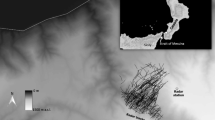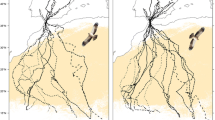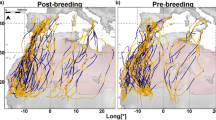Abstract
During migrations, birds have to cope with varying meteorological conditions, which shape their migratory routes and affect their performance. Amongst these, wind is the main meteorological agent influencing behaviour of birds in their migration journeys. Here we analyze the effect of winds during migrations of adult individuals of two raptor species tracked with satellite telemetry, the Montagu’s harrier (Circus pygargus) and the lesser kestrel (Falco naumanni). While harriers use mostly soaring flight, kestrels principally use flapping flight and thus, wind can differently affect these birds. We found that both forward and perpendicular winds significantly affected the movements of the Montagu’s harrier, which were drifted from their intended direction but also took advantage of tailwinds. On the contrary, lesser kestrels moved more regardless of forward winds, despite they were highly drifted by crosswinds. Our results also support that the drifting effect of winds at the onset of the spring migration may explain the loop migration observed for both species, with birds compensating later the effect of crosswinds to arrive to their breeding areas. Results presented here illustrate how winds can differently affect migrating birds according to their flight modes.


Similar content being viewed by others
References
Alerstam T (1979) Optimal use of wind by migrating birds: combined drift and overcompensation. J Theor Biol 79:341–353
Alerstam T (2001) Detours in bird migration. J Theor Biol 209:319–331
Alerstam T (2009) Flight by night or day? Optimal daily timing of bird migration. J Theor Biol 258:530–536
Alerstam T (2011) Optimal bird migration revisited. J Ornithol 152:5–23
Alerstam T, Hedenström A (1998) The development of bird migration theory. J Avian Biol 29:343–369
Alerstam T, Hake M, Kjellén N (2006) Temporal and spatial patterns of repeated migratory journeys by ospreys. Anim Behav 71:555–566
Argos (2011) Argos user’s manual. Worldwide tracking and environmental monitoring by satellite. CLS, Toulouse
Catry I, Dias MP, Catry T, Afanasyev V, Fox J, Franco AMA, Sutherland WJ (2011) Individual variation in migratory movements and winter behaviour of Iberian Lesser Kestrels Falco naumanni revealed by geolocators. Ibis 153:154–164
Chapman JW, Nesbit RL, Burgin LE, Reynolds DR, Smith AD, Middleton DR, Hill JK (2010) Flight orientation behaviors promote optimal migration trajectories in high-flying insects. Science 327:682–685
Cramp S, Simmons KEL (1980) The birds of the Western Paleartic, vol 2. Oxford University Press, Oxford
Elkins N (2004) Weather and bird behaviour, 3rd edn. T & AD Poyser, London
Felicísimo ÁM, Muñoz J, González-Solís J (2008) Ocean surface winds drive dynamics of transoceanic aerial movements. PLoS One 3:e2928
García-Ripollés C, López-López P, Urios V (2010) First description of migration and wintering of adult Egyptian Vultures Neophron percnopterus tracked by GPS satellite telemetry. Bird Study 57:261–265
Gauthreaux SA, Michi JE, Belser GG (2005) The temporal and spatial structure of the atmosphere and the evolution of bird migration. In: Greenberg R, Marra PP (eds) Birds of two worlds: the ecology and evolution of migration. John Hopkins University Press, West Sussex, pp 182–192
Green M, Alerstam T (2002) The problem of estimating wind drift in migrating birds. J Theor Biol 218:485–496
Gwinner E (1996) Circannual clocks in avian reproduction and migration. Ibis 138:47–63
Harrison XA, Blount JD, Inger R, Norris DR, Bearhop S (2011) Carry-over effects as drivers of fitness differences in animals. J Anim Ecol 80:4–18
Kanamitsu M, Ebisuzaki W, Woollen J, Yang S-K, Hnilo JJ, Fiorino M, Potter GL (2002) NCEP–DOE AMIP-II reanalysis (R-2). B Am Meteor Soc 83:1631–1643
Kemp MU, Shamoun-Baranes J, Van Gasteren H, Bouten W, Van Loon EE (2010) Can wind help explain seasonal differences in avian migration speed? J Avian Biol 41:672–677
Kemp MU, Van Loon EE, Shamoun-Baranes J, Bouten W (2012) RNCEP: global weather and climate data at your fingertips. Method Ecol Evol 3:65–70
Kenward RE (2001) A manual for wildlife radio tagging. Academic Press, London
Kerlinger P (1989) Flight strategies of migrating hawks. University of Chicago Press, Chicago
Klaassen RHG, Strandberg R, Hake M, Olofsson P, Tottrup AP, Alerstam T (2010) Loop migration in adult marsh harriers Circus aeruginosus as revealed by satellite telemetry. J Avian Biol 41:200–207
Klaassen RHG, Hake M, Strandberg R, Alerstam T (2011a) Geographical and temporal flexibility in the response to crosswinds by migrating raptors. Proc R Soc Lond B 278:1339–1346
Klaassen RHG, Alerstam T, Carlsson P, Fox JW (2011b) Great flights by great snipes: long and fast non-stop migration over benign habitats. Biol Lett 7:833–835
Kokko H (1999) Competition for early arrival in migratory birds. J Anim Ecol 68:940–950
Liechti F (2006) Birds: blowin’ by the wind? J Ornithol 147:202–211
Limiñana R, Soutullo A, Urios V (2007) Autumn migration of Montagu’s Harriers Circus pygargus tracked by satellite telemetry. J Ornithol 148:517–523
Limiñana R, Romero M, Mellone U, Urios V (2012a) Mapping the migratory routes and wintering areas of Lesser Kestrels Falco naumanni: new insights from satellite telemetry. Ibis 154:389–399
Limiñana R, Soutullo A, Urios V, Reig-Ferrer A (2012b) Migration and wintering areas of adult Montagu’s Harriers (Circus pygargus) breeding in Spain. J Ornithol 153:85–93
Limiñana R, Soutullo A, Arroyo B, Urios V (2012c) Protected areas do not fulfil the wintering habitat needs of the trans-Saharan migratory Montagu’s Harrier. Biol Conserv 145:62–69
López-López P, Limiñana R, Mellone U, Urios V (2010) From the Mediterranean Sea to Madagascar: are there ecological barriers for the long-distance migrant Eleonora’s Falcon? Landsc Ecol 25:803–813
Maggini I, Bairlein F (2012) Innate sex differences in the timing of spring migration in a songbird. PLoS One 7:e31271
Mateos-Rodríguez M, Liechti F (2012) How do diurnal long-distance migrants select flight altitude in relation to wind? Behav Ecol 23:403–409
Mellone U, López-López P, Limiñana R, Urios V (2011) Weather conditions promote route flexibility during open ocean crossing in a long-distance migratory raptor. Int J Biometeorol 55:463–468
Mellone U, Klaassen RHG, Garcia-Ripolles C, Limiñana R, López-López P, Pavon D, Strandberg R, Urios V, Vardakis M, Alerstam T (2012) Interspecific comparison of the performance of soaring migrants in relation to morphology, meteorological conditions and migration strategies. PLoS One 7:e39833
Meyburg BU, Paillat P, Meyburg C (2003) Migration routes of Steppe Eagles between Asia and Africa: a study by means of satellite telemetry. Condor 105:219–227
Meyer SK, Spaar R, Bruderer B (2000) To cross the sea or to follow the coast? Flight directions and behaviour of migrating raptors approaching the Mediterranean Sea in autumn. Behaviour 137:379–399
Morganti M, Mellone U, Bogliani G, Saino N, Ferri A, Spina F, Rubolini D (2011) Flexible tuning of departure decisions in response to weather in black redstarts Phoenicurus ochruros migrating across the Mediterranean Sea. J Avian Biol 42:323–334
Pennycuick CJ (1989) Bird flight performance: a practical calculation manual. Oxford University Press, Oxford
R Development Core Team (2010) R: a language and environment for statistical computing. R Foundation for Statistical Computing, Vienna, http://www.r-project.org/
Rayner JMV (1990) The mechanics of flight and bird migration performance. In: Gwinner E (ed) Bird migration. Springer, Berlin, pp 283–299
Richardson WJ (1978) Timing and amount of bird migration in relation to weather: a review. Oikos 30:224–272
Rodríguez A, Negro JJ, Bustamante J, Fox JW, Afanasyev V (2009) Geolocators map the wintering grounds of threatened Lesser Kestrels in Africa. Divers Distrib 15:1010–1016
Rodríguez A, Alcaide M, Negro JJ, Pilard P (2011) Using major histocompatibility complex markers to assign the geographic origin of migratory birds: examples from the threatened Lesser Kestrel. Anim Conserv 14:306–313
Saino N, Rubolini D, Von Hardenberg J, Ambrosini R, Provenzale A, Romano M, Spina F (2010) Spring migration decisions in relation to weather are predicted by wing morphology among trans-Mediterranean migratory birds. Funct Ecol 24:658–669
Schmaljohann H, Bruderer B, Liechti F (2008) Sustained bird flights occur at temperatures beyond expected limits of water loss rates. Anim Behav 76:1133–1138
Schmaljohann H, Liechti F, Bruderer B (2009) Trans-Sahara migrants select flight altitudes to minimize energy costs rather than water loss. Behav Ecol Sociobiol 63:1609–1619
Schmaljohann H, Fox JW, Bairlein F (2012) Phenotypic response to environmental cues, orientation and migration costs in songbirds flying halfway around the world. Anim Behav 84:623–640
Shamoun-Baranes J, Baharad A, Alpert P, Berthold P, Yom-Tov Y, Dvir Y, Leshem Y (2003) The effect of wind, season and latitude on the migration speed of White Storks Ciconia ciconia, along the eastern migration route. J Avian Biol 34:97–104
Shamoun-Baranes J, Van Loon E, Liechti F, Bouten W (2007) Analyzing the effect of wind on flight: pitfalls and solutions. J Exp Biol 210:82–90
Spaar R (1997) Flight strategies of migrating raptors: a comparative study of interspecific variation in flight characteristics. Ibis 139:523–535
Spaar R, Bruderer B (1997) Migration by flapping or soaring: flight strategies of Marsh, Montagu’s and Pallid harriers in southern Israel. Condor 99:458–469
Spaar R, Herbert S, Liechti F (1998) Migratory flight strategies of Levant Sparrowhawks: time or energy minimization? Anim Behav 56:1185–1197
Strandberg R, Klaassen RHG, Olofsson P, Alerstam T (2009) Daily travel schedules of adult Eurasian Hobbies Falco subbuteo – variability in flight hours and migration speed along the route. Ardea 97:287–295
Strandberg R, Klaassen RHG, Hake M, Alerstam T (2010) How hazardous is the Sahara Desert crossing for migratory birds? Indications from satellite tracking of raptors. Biol Lett 6:297–300
Thorup K, Alerstam T, Hake M, Kjellén N (2003) Bird orientation: compensation for wind drift in migrating raptors is age dependent. Proc R Soc Lond B 270:8–11
Thorup K, Alerstam T, Hake M, Kjellén N (2006) Traveling or stopping of migrating birds in relation to wind: an illustration for the osprey. Behav Ecol 17:497–502
Thorup K, Holland RA, Tøttrup AP, Wikelski M (2010) Understanding the migratory orientation program in birds: extending laboratory studies to study free-flying migrants in a natural setting. Integr Comp Biol 50:315–322
Trierweiler C, Koks BJ (2009) Montagu’s Harrier Circus pygargus. In: Zwarts L, Bijlsma RG, van der Kamp J, Wymenga E (eds) Living on the edge: wetlands and birds in a changing Sahel. KNNV Publishing, Zeist, pp 312–327
Vardanis Y, Klaassen RHG, Strandberg R, Alerstam T (2011) Individuality in bird migration: routes and timing. Biol Lett 7:502–505
Weimerskirch H, Louzao M, de Grissac S, Delord K (2012) Changes in wind pattern alter albatross distribution and life-history traits. Science 335:211–214
Acknowledgments
We are grateful to Aeropuerto de Castellón and FCC-Energía/Enerstar Villena S.A. for funding the satellite tracking projects of Montagu’s harriers and lesser kestrels, respectively. We are thankful to Servicio de Biodiversidad (Conselleria de Infraestructuras, Territorio y Medio Ambiente), especially to Juan Jiménez and Juan Antonio Gómez for collaboration and giving all the necessary permissions for bird’s tagging. We are grateful to H. Schmaljohann and an anonymous referee for very useful comments that improve the manuscript. R.L. had a postdoctoral grant (Reference 10/12-C) co-funded by Consejería de Educación y Ciencia (Junta de Comunidades de Castilla-La Mancha) and the European Social Fund during the development of this study. U.M. is supported by an FPU grant of the Spanish Ministry of Education (AP2008-0947). This paper is part of the PhD thesis of M.R. at the University of Alicante.
Ethical standards
This work complies with the current environmental laws in Spain, and all necessary permissions to catch and deploy PTTs on tracked species were provided by the regional government (Conselleria de Infraestructuras, Territorio y Medio Ambiente; Generalitat Valenciana).
Conflict of interest
The authors declare that no conflict of interest exists.
Author information
Authors and Affiliations
Corresponding author
Additional information
Communicated by W. Wiltschko
Rights and permissions
About this article
Cite this article
Limiñana, R., Romero, M., Mellone, U. et al. Is there a different response to winds during migration between soaring and flapping raptors? An example with the Montagu’s harrier and the lesser kestrel. Behav Ecol Sociobiol 67, 823–835 (2013). https://doi.org/10.1007/s00265-013-1506-9
Received:
Revised:
Accepted:
Published:
Issue Date:
DOI: https://doi.org/10.1007/s00265-013-1506-9




